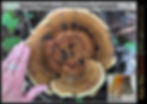Dyer's Polypore
- katemacquarrie22
- Sep 7, 2025
- 2 min read
Updated: Sep 27, 2025
Welcome back to Mushroom Monday, your weekly look at some of PEI’s fascinating fungi. Today it’s the common, beautiful, and ecologically-important Dyer’s Polypore (Phaeolus hispidoides).

We’ve looked at the Polypore group before, including last week’s Cinnabar Polypore. Polypores usually grow like brackets from the sides of trees, but Dyer’s Polypore doesn’t like to follow rules. It often looks more like a messy cluster than a bracket and can sometimes appear to be growing from the ground as is the case here. This Polypore is actually attached to the root of a Spruce tree; they can also be found growing from the bases of various conifers.
If you’ve ever noticed a cut tree that was rotten in the centre, especially near the base, you’ve seen Butt Rot. Dyer’s Polypore is one of many fungi that can cause this. This mushroom is native throughout North America, and its mycelia – the thread-like body of the fungus – can be found in forest soil. When those mycelia or the mushroom’s spores encounter a weak spot on a tree (a current wound or a scar from previous damage, for example), the fungus can enter the tree.
Once inside, Dyer’s Polypore begins digesting cellulose, a key component of wood that helps give it strength. This happens in the tree’s heartwood and so doesn’t affect transport of water, sugar, and nutrients between canopy and roots. For this reason, there are often very few early signs that the fungus is present; by the time it fruits to produce the Polypores we see, the rot can be quite advanced.
While Butt Rot is considered negative when it damages trees we value, it plays important roles in forests: contributing to nutrient cycling; creating habitat for mammals, birds, amphibians, and invertebrates; and leaving behind lignin which helps build forest soil and contributes to carbon storage.
You can reduce the chance of Butt Rot in economically or culturally-important trees by taking steps to avoid damage, especially to the lower trunk (watch those weed-whackers!). If you see Dyer’s Polypores, know that internal rot is underway and it’s only a matter of time before the tree comes down.
In addition to its ecological role, Dyer’s Polypore is useful for dying textiles, producing colours from rich yellow and orange to deep green and brown (inset photo). It’s considered a good mushroom for beginner dyers because it’s easy to find and identify and is pretty forgiving with the dye process.
Dyer’s Polypores are flat-topped fungi with concentric rings in shades of tan, olive, or brown and a pale outer ring (main photo). Younger specimens are velvety on top, but this texture is often lost as the mushroom matures. Under the cap are pores that are yellow to orange when young, changing to olive or brown over time. Those pores turn dark when bruised or cut.
Dyer’s Polypore is common across the Island and most commonly seen in late summer and fall. Keep an eye out for this interesting fungus as you explore PEI Untamed!
